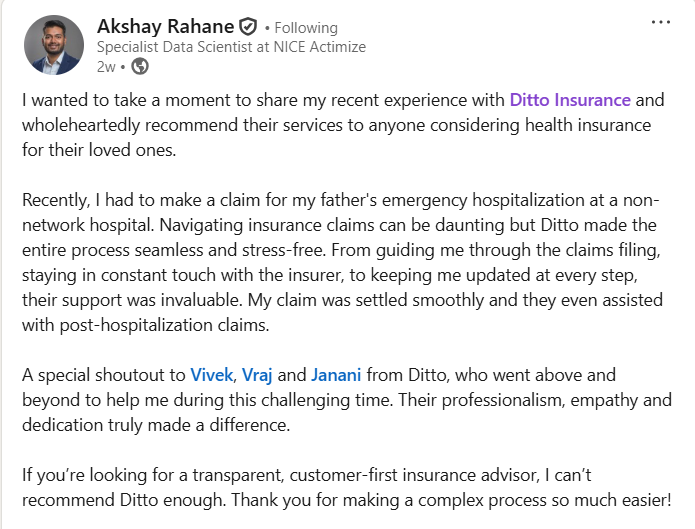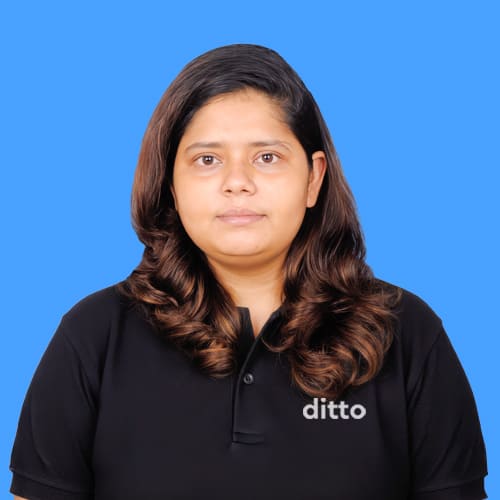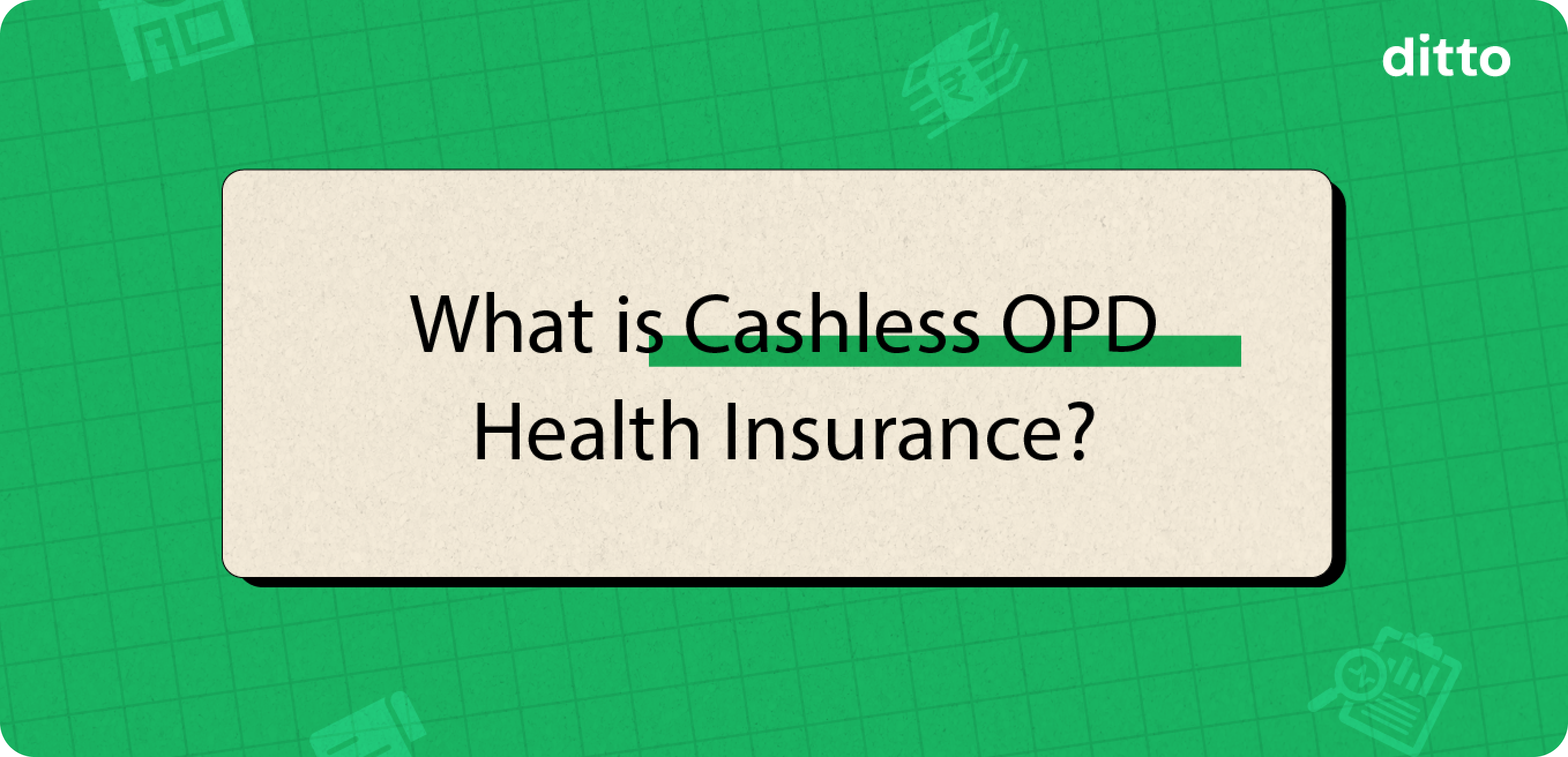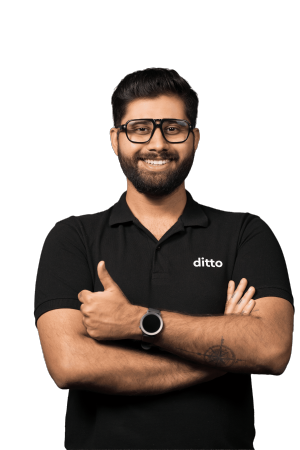Cashless OPD health insurance: Overview
Cashless OPD health insurance lets you access outpatient doctor consultations without paying upfront, provided you use the insurer’s empanelled network and follow the insurer’s cashless booking process. Usually, OPD refers to doctor consultations only; diagnostics and medications are not included unless the specific plan or add-on explicitly covers them (subject to monetary caps).
Introduction
Ever walked into a clinic thinking your health insurance would cover the visit, only to be handed the full bill at the counter? You’re not alone. OPD (Outpatient Department) coverage is one of the most misunderstood parts of health insurance. Most people don’t realize what’s actually included: doctor consultations, diagnostic tests, even prescribed medicines. Having seen thousands of OPD claims at Ditto, we’ve noticed one thing: the confusion is real. So, here’s a simple guide to help you understand what cashless OPD health insurance really covers, how to use it smartly, and which plans actually make it worth your money.
Combing the internet to find an OPD health plan that fits your lifestyle? At Ditto, we help you compare plans, understand real coverage (consultations, diagnostics, and pharmacy), and choose what’s genuinely worth the premium — book a free 1-on-1 call with our advisor today.
What Does OPD Cover Typically Include?
- Doctor consultations (General Practitioners, listed specialists, follow-ups, tele-consults).
- Some plans may include physiotherapy, mental health sessions like counselling and psychiatric sessions, and specialist allied services; check the policy’s list of covered doctor types.
- Diagnostics and medications are not standard; when present, they come via add-ons or premium plans and are subject to monetary caps.
- Example: Niva Bupa Aspire Titanium+ with its “Well-Consult add-on” offers up to ₹10,000 for in-person doctor visits and diagnostics, and ₹2,500 for pharmacy expenses. At the same time, HDFC ERGO’s Optima Secure plan’s Wellbeing add-on offers up to 50% discounts on lab tests, scans, and medicines, along with other benefits like in-clinic and tele consultations, fitness classes, etc.
- Annual health checks are covered only if the base plan or add-on explicitly includes them, and only for the tests listed in the policy or up to monetary caps.
Why OPD Cover Matters
- Covers recurring medical expenses like doctor visits, diagnostics, and medicines without hospitalisation.
- Especially beneficial for people with chronic conditions, families with young children, and senior citizens needing regular care.
- Reduces out-of-pocket spending on routine healthcare.
- Promotes preventive check-ups and early diagnosis.
- Offers convenience through cashless e-consults and physical OPD visits.
- Minimises billing and reimbursement hassles with direct settlements.
Types of OPD Coverage and Plans
Common Mistakes to Avoid When Buying Health Insurance That Covers OPD
- Assuming OPD always includes diagnostics and medicines, which is often not accurate unless stated.
- Ignoring monetary caps for diagnostics or medicines, for example, Niva Bupa’s ₹10,000 diagnostics limit, and considering overall OPD restrictions such as annual caps, per-visit limits, pharmacy sub-limits, and co-pays for non-network services.
- Overlooking the doctor types included, is it only General Practitioner, or a full specialist list?
- Not checking network proximity can be a mistake; cashless physical OPD insurance usually works only within a designated OPD network (separate from the hospitalization network). You’ll usually need to book appointments through your insurer’s app, and there might be a short wait. If you visit a doctor outside the network, you’ll likely have to file a reimbursement claim and pay part of the bill yourself.
- Not verifying whether OPD claims affect no-claim bonuses (usually, it doesn’t).
Premiums of OPD Health Insurance
Note: The profile considered in the above table is for a 25-year-old individual living in Mumbai with no pre-existing diseases.
Are Daycare and OPD the Same?
No. OPD refers to outpatient visits without hospital admission. Day-care treatments are procedures requiring hospital admission (primarily <24 hours) and are typically covered under the base sum insured. Daycare treatments, such as cataract removal and chemotherapy, do not require an add-on, unlike OPD treatments.
Ditto’s Take on OPD Coverage
Choosing the right OPD health insurance means understanding exactly what you’re paying for and how you’ll use it.
- Start by defining the OPD scope. Check if the plan covers only doctor consultations or also includes diagnostics, prescribed medicines, dental, or vision care. Note the annual OPD cap, as well as any category-wise or per-visit limits.
- Next, scan the fine print for sub-limits, co-pays, waiting periods, and whether prescriptions or pre-authorizations are needed. Some plans also apply pharmacy sub-limits or non-network co-pays, so review these closely.
- Confirm which providers are covered, including whether both general practitioners and specialists (or even super-specialists) are included, and if referrals are required.
- Validate cashless access — OPD cashless usually runs on a separate network from hospitalization, so check the list of partner clinics, labs, and pharmacies. Understand the app-based booking and e-card process, as some plans may require pre-appointment approval or short waiting periods.
- Pick your preferred access mode — some plans focus heavily on unlimited teleconsultations, while others offer broader in-person OPD networks. At Ditto, we usually lean toward plans with stronger physical network access since they’re more practical day to day.
- Understand reimbursement fallback — for non-network consultations, see what paperwork, receipts, and claim timelines apply, and whether any co-pay or limit reduction is triggered.
- Finally, weigh the cost against your actual usage. If you rarely visit clinics, paying OPD expenses out of pocket might be more economical than paying extra premium for limited coverage.
How to File an OPD Claim: Step-by-Step
Cashless OPD Health Insurance (network):
- Inform the insurer or book via the app before the appointment.
- Use an empanelled doctor/clinic.
- Insurer settles directly (subject to policy terms).
Reimbursement OPD Health Insurance (non-network or allowed):
- Pay the treatment cost upfront.
- Collect original bills, prescriptions, and reports.
- Fill the claim form with policy details and service description.
- Submit via email/courier within the specified timeframe.
- Insurer processes and reimburses as per caps and admissibility.
Why Talk to Ditto for Your Health Insurance?
At Ditto, we’ve assisted over 8,00,000 customers with choosing the right insurance policy. Why customers like Srinivas below love us:

✅No-Spam & No Salesmen
✅Rated 4.9/5 on Google Reviews by 5,000+ happy customers
✅Backed by Zerodha
✅100% Free Consultation
You can book a FREE consultation. Slots are running out, so make sure you book a call now!
Conclusion
Cashless OPD health insurance is a powerful addition when chosen right. Focus on consultation-cover as the baseline. Diagnostics and meds are bonus perks, check for caps and explicit inclusion. The right OPD cover can turn frequent doctor visits into seamless, cost-effective care.
FAQs
How is OPD cover different from hospitalization cover?
OPD cover handles outpatient doctor consultations without admission. Their hospitalization cover takes care of treatments requiring a hospital bed (admission, surgery, overnight stay or daycare).
Do OPD plans cover diagnostics and medicines?
Not always. Often, OPD is limited to consultations. Some plans/add-ons include diagnostics/medicines, but with monetary caps and specific test lists.
What is cashless OPD?
Cashless OPD means you don’t pay at the time of service if you use the insurer’s network and follow the insurer’s pre-appointment booking process. The insurer settles with the clinic. Otherwise, you may pay and claim reimbursement.
Can I claim from a non-network doctor under OPD cover?
Only in plans that offer reimbursement for non-network usage. You’ll pay upfront, then submit original bills, prescriptions, and the claim form via email or courier. This may take longer and be subject to copays and sub-limits.
What is Even, and does it offer OPD?
Even (Even Healthcare) isn’t an insurer but a managed-care membership platform. It provides OPD services like doctor consultations and diagnostics through its app and partner clinics, while any hospitalisation cover (if opted for) is backed by a group health-insurance policy from a partner insurer such as Magma HDI. Always check your plan details and city network before enrolling.
Is cashless OPD available “everywhere,” like Cashless Everywhere?
No. The Cashless Everywhere initiative applies to hospitalisation claims, not OPD services. Cashless OPD is limited to the insurer’s tied network of clinics, labs, and pharmacies—outside this network, you’ll typically need to pay upfront and claim reimbursement later.
Last updated on:










